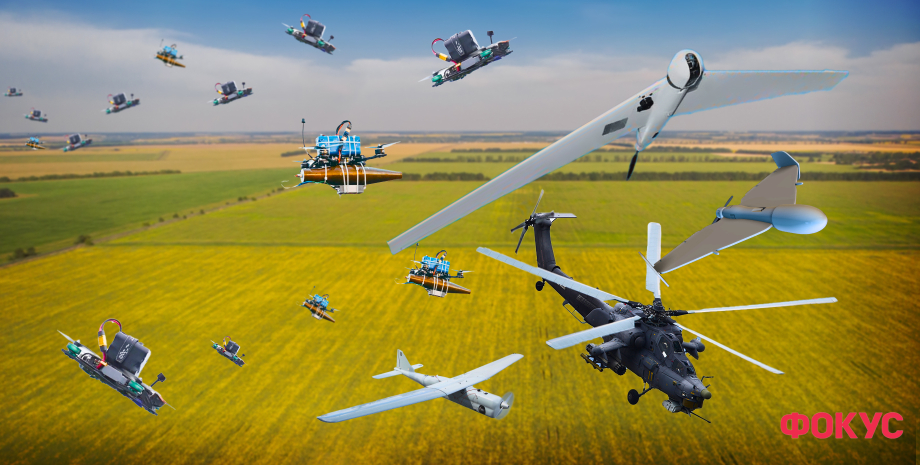
 By Victor Duda
By Victor Duda
For this purpose, they turned to manufacturers of FPV-oules, which are participants of the Brave Inventors platform. The Charity Fund "Come back alive" has launched an action called "Dronopad", which aims to knock down 1,000 Russian reconnaissance UAVs with the help of modernized FPV-punks.
The Fund noted that dozens of "scouts" of the Armed Forces fly over the front line and in the back of Ukraine, collecting and transmitting information about the location and movement of defense or critical infrastructure, which is why they need to be knocked down. Priority, new drones-interceptors, together with other equipment, should receive fighters of the 38th Marine Corps of the Armed Forces, who have already successfully hunted the enemy's intelligence devices.
The famous blogger and volunteer Sergey Sternenko began and has already closed the collection called "Heavenly Russors", collecting about 70 million hryvnias on drones, capable of knocking down UAV-reconnaissance. He noted that recently the Ukrainian military with the help of FPV-digs has already knocked down dozens of Russian "eagles", Zala and SuperCam, which are cited by missiles and lancet-type lancers.
The Russians, meanwhile, complain that the drum drones are chatting on their intelligence machines, and then rammed or blown away, causing significant damage. The focus talked with Ivan Shishkin, an engineer of Drons Birds, which produces FPV-Drones "Bird-10", they withstand up to 3. 5 kg of useful cargo, and with a load of 650 grams can fly up to 30 km. In addition, the company also works on the system for the destruction of reconnaissance drones.
According to Ivan Shishkin, each UAV has its own technical characteristics, which must be taken into account in order to knock it down: speed, maneuverability, resistance to the tools of the HRS, availability of the trapping system, the possibility of deviation from the route. In addition, drones can change the speed and direction depending on the relief that they fly over, or what task received.
They can fly to a certain place and unexpectedly change their direction and speed - turn around, fly a completely different route. This is done to confuse the air defense system in many different places. "Therefore, all this should be taken into account. If it is reconnaissance UAVs, then they usually fly long, but not very quickly. For example," Orlan-10 "is a quick but quite irreversible UAV. They can be intercepted by making drones that They will fly high, there will be certain guidance systems.
Focus also addressed Anna Chudnovets, the director of Sokilskay LLC, which produces FPV-Kamikadze "Wam-200"-the apparatus has already been tested by the Ministry of Defense and is used by defense forces in battles. She added that in addition to the technical characteristics, the high pilot skills also need to be able to control the FPV-roma very well and have extensive orientation experience in space.
For example, "lancet" can fly at a height of 1000 meters, and FPV-Dron, depending on the characteristics of the components-is a working height of 50-100 meters, the maximum can be 500-1000, sometimes higher. "At the moment when the FPV interceptor rises after another enemy drone for beat, he needs to rise higher than this enemy drone to keep him in sight and then attack.
At that moment he can" fall out "video, for example, through fog, Rain, or strong wind, and the pilot should keep his drone before the appearance It has a very good speed and very quickly accelerates. Ivan Shishkin named several options for destroying such goals. First, you can suppress radio communications, you need to have a device on board that will stupid the connection of the UAV for which the hunting is conducted, as well as the battery, many antennae, interference generators.
All drones will suffer in a certain radius, even friendly if they work at the same frequencies. You can also use a directional or not directed charge, which will affect the drone of the enemy with fragments, shrapnel or something else. In this case, most likely, the explosion will suffer from the explosion. Another option is to cover the enemy UAV with a grid to entangle the screws and make it fall. To do this, the pilot must very skillfully and confidently manage the "hunter" and be very accurate.
"Making a drone is a half thing, it is necessary to think of how not to lose it, destroying the enemy. To exchange one for one-it is not very interesting, interesting when you can knock down 10-15 drones of opponent with one drone," Ivan Shishkin said . Sokilskay's representative is convinced that FPV-Drons can also be killed by Iranian shock-offs Shahamed and their Russian copies of Herbera, who recently started using.
You need a copter with greater maneuverability, the ability to rise to a height above 500 meters without loss of telemetry data. To do this, you need to put more powerful transmitters that can keep a normal connection with the pilot. "I think you can knock out" Shahda "without questions, the only thing that should be drones with very good characteristics," - added the director of Sokilskay.
On August 6, according to the focus of the source in special services, the FPV-Dron struck the helicopter Mi-28 of the Armed Forces of the Russian Federation in the Kursk region during the operation of the Security Service of Ukraine. On August 9, a video appeared how such a drone attacked the Mi-8, also in the Russian territory. Ivan Shishkin says that the screws can be affected systematically, they, as a goal, are no different from the tank, except that they do not have armor.
This is as big, very hot (because the hot engine) and the slow machine. It is enough to hit any place: fuel line, engine, screw. The biggest problem is to find a screw. The difficulty is that the screws take off unexpectedly. If the pilot retains radios, then the defense forces do not know when and where it flies, then it all depends on luck. Those sprains that were destroyed during the war in Ukraine were in the parking lot or just flew.
You can find a parking lot with a reconnaissance drone, and after an intelligence already destroy the fighting machine with a shock machine. Many developers are now trying to increase the speed or maneuverability of the interceptors so that they can catch up with the enemy. Ivan Shishkin has already seen several options that develop speed of about 300-400 kilometers per hour. In addition, endurance plays an important role.
"Let's say so, they have reached a confident 350 km per hour, but have not yet reached mass production, unfortunately," he said. "There are some interceptors who are pretty shunting and fast, but do not have enough energy to persecute the target for a long time. If the pilot. found the target, Tom is only 4-5 minutes to destroy it. Other teams focus on the creation of drone, which will find goals itself.
If the UAV is flying on the intended route, it can most likely be calculated mathematically and intercept. If the device can change the route, be guided by a pilot or make decisions, based on the situation, having some rudiments of artificial intelligence, then you need to have a good guidance system. If the enemy drone has a certain heat track, then the interceptor can track it with a heat chamber.
Each drone that uses certain frequencies has a certain "imprint" of radio, which can be recognized and gathered. Some UAVs work loudly, so they can be determined by sound by setting microphones on the interceptor. In this way, you can detect a "shaha" whose engine has a characteristic sound. "The most technological will be intercepting with computer vision. If you train, for example, a neural network recognize certain features of a certain drone in the air-it will be the most accurate interception.
You can even make a certain visual label of" your own-famous ", attaching to your drone QR code Or any other mark. Or visual images with the help of artificial intelligence, " - said the representative" Bird Drons ". The weak place of guidance systems is moving goals that can change the direction or speed of movement. Ivan Shishkin personally knows three teams that work on car, although in fact they are much more. Some of them already have excellent experience, but not 100% efficiency.
"I was on several trials and I can say that the guidance is effective about 80-90%," Ivan says. The Drone Bird is now working on the technology of lesions of drones that slowly move or hang in the air - scouts or bombers, but it is difficult for pilots. According to the engineer, it would be great to combine this technology with developments in the field of proof systems. "If complementing works confident enough if it is 3D pointing, not how it works now-it will be interesting.
Frankly, it is now 2. 5D, because the drone holds a two-dimensional picture and gives this picture to the center. Or some kind of picture The square or rectangle binds this picture. , - he shared. According to Anna Chudnovets, in Ukraine are already looking for manufacturers who can make a solution that will allow to intercept and intelligence drones, "Shahda" and other threats.
"I cannot name the company, but it is developing a complex that brings together not only a drone-interceptor with homing, but also a station that reveals enemy UAV. What interception is not to forgive one drone with a pilot, but a whole system that must be properly configured, "she stressed.
Anna Chudnivtsi believes that complex FPV-punks are inappropriate to use in frontline territories, for example, to protect positions, observation points or armor of the Ukrainian military, they need mobile complexes. However, this approach should be useful to protect cities, as you can place such tools here. In addition to copter, there is a rather rare type of drone - small airplanes with FPV type control, that is, with a first person.
The Armed Forces of the Russian Federation has recently been actively using devices called "Lightning", in Ukraine, UAVs called Darts ("Darts") are made in Ukraine. Interestingly, the Ukrainian product has recently received the system of automatic bringing to the target. The focus asked the manufacturers whether such devices could be used to intercept different Russian tools in the sky.
Ivan Shishkin says that the FPV-aroma is the same disadvantages as Kopters, for example, vulnerable to the remedies of HR, but have much better energy supply, they can fly longer on the same engines and with the same batteries, because, thanks to some physical physical The laws, their wings support the air. In doing so, they consume less energy, move on, and under certain conditions have a higher speed.










All rights reserved IN-Ukraine.info - 2022